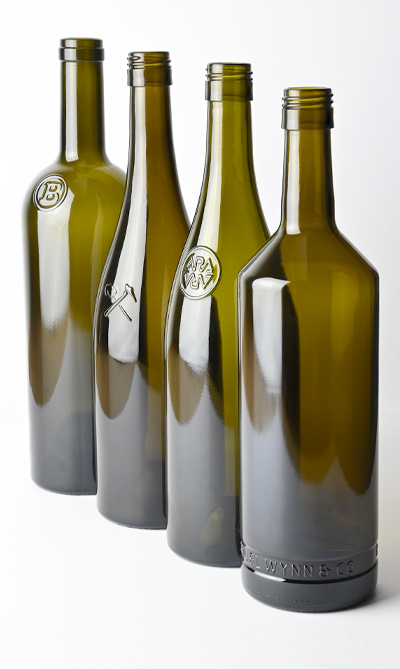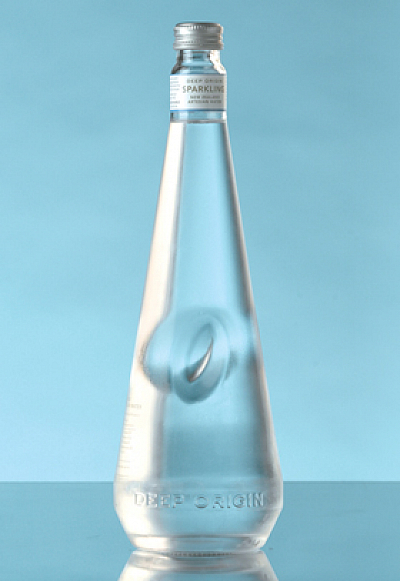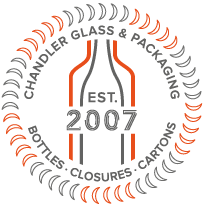Embossing & Debossing
Choose an existing bottle form and add your company logo, brand name or signature as an embossed element. Some logo designs can also be debossed. Mould set up costs are minimal, however a minimum order quantity of 300,000 units does apply.
Embossing is a raised design element on the bottle, sitting proud of the bottle's exterior wall. De-bossing is an element that is recessed in the glass wall. An embossed or de-bossed element separates your wine from the mass of competitors, ensuring your brand stands out.
These types of embellishments are particularly well regarded in North American and Asian markets, so are often used on exported wine bottles. Embossing and de-bossing gives the customer the sense that they are drinking wine from an established and reputable producer.
Bottle embossing or de-bossing has never been so easy and inexpensive as it is with Chandler.
Today, in most cases, we can add your brand logo, crest or signature as an embossed or debossed element to an existing mould shape for minimal cost.
For French Green, Antique or Flint coloured bottles we produce an MOQ of around 300,000 units, which you can draw from as required (delivery minimums do apply).

Unique bottle design
The ultimate in customisation. Create a unique bottle design to fit your brand image.
With over 30 years experience in the wine & beverage industry, Chandler can guide you through the process to create unique glass packaging that is functional, aesthetic, economic, practical for handling and performs to your expectations, always.
We are one of the few companies in Australasia that can provide a comprehensive range of services focusing on bottle performance and design. We can recommend various closure options and determine what bottling, capping and labeling equipment may be required to be installed or altered. We can also adapt bottle mouth finishes to suit almost any type of closure.
Chandler can work with your own creations or you can work with our affiliated enterprise, Grenache Bottle Design, to workshop, develop and design a unique glass package that is truly yours.
Mould establishment costs do apply.
For French Green, Antique, Dark Green or Flint coloured bottles we produce an MOQ of around 300,000 units, which you can draw from as required (delivery minimums do apply).
For Crystal glass, High Flint and Extra Flint, the MOQ is 50,000 units.

Bottle moulds
Designing a unique bottle involves the development of a new bottle mould. Prices of a new mould vary depending on your annual demand and run size.
WINE
Mould establishment costs of an embossed or de-bossed brand element on an existing bottle form is approx. USD 25,000, depending on final design, for a completely new bottle shape with or without personalised embellishments.
SPIRIT
Spirit bottle mould establishment costs can range between USD 4,000 and USD 18,000. The quantity of bottles required and run size determines which supplier and therefore manufacturing equipment is to be used. The quantity of mould sets varies considerably between factories and glass blowing equipment.

Location devices
A location device is only required for bottles that require a body label to be applied in a registered, specific position — usually under an embossed or de-bossed design element.
This device is permanently incorporated in the bottle moulds and for NZ a Labelling Spotting Bar is usually used, positioned low on the rear panel of the bottle. More commonly used in Australia, is the base notch device, aka: keyway or punt lug.
The raised shoulder mark for locating and positioning bottles, using a ‘mark’ sensor is a fairly recent development and will need trials at your bottler to determine reliability of performance.
The selected device is determined by your labelling equipment and its capability to physically locate bottles on a particular device type.
It is worth noting that many bottling lines can now detect the emboss element by electronic sensor, avoiding the need to add any location device on the bottle. This needs to be thoroughly tested at your selected bottler.
Labelling Spotting Bar device
The de-bossed double Spotting Bar element is usually located on the rear of the bottle and is suited for a left or right running labellers (A single spotting bar is possible if the direction of the labeller is known). It has to be accurately dimensioned in order to perform reliably and the centre position is required to be between 17mm and 41mm, adjusted at the bottle mould stage, to suit specific labelling equipment. The double Spotting Bar is not normally used on 750ml bottles that are less than 525g, due to the risk of the glass wall becoming too thin around this de-bossed element. This device is specifically included on bottles to suit labelling equipment that is fitted with a mechanical rotating and locating device, usually positioned at the tail of worm in-feed of the labeller. Upon entering the labeller, the bottles are rotated until the base Spotting Bar notch is aligned with the locator device. This system is more common in NZ.
Base / heel Notch device
The base notch element is located at the heel of the bottle, traversing the bearing surface of the bottle. This element is specifically included on bottles to suit labelling equipment that is fitted with a mechanical rotating and locating device, usually positioned at the tail worm in-feed of the labeller. Upon entering the labeller, the bottles are rotated until the base notch is aligned – snaps into the location device. This system is more common in Australia and Europe.
Raised Location Mark
The embossed lozenge shaped element located on the shoulder or body of a bottle is specifically designed for labelling equipment that is fitted with optical ‘mark’ sensors. Upon entering the labeller, the bottles are mechanically rotated either at the worm in-feed or, individually rotated on the bottle pedestals, to align with the embossed mark. Specific ‘Mark’ sensors need to be fitted to the labeller, or this embossed mark will have no functionality.
Important note:
When changing to Chandler wine bottles, typically there is zero to minimal bottling line adjustment, required.



